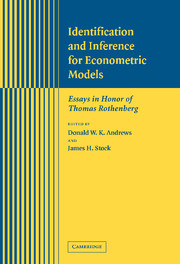Book contents
- Frontmatter
- Contents
- List of Contributors
- Preface
- Part I Identification and Efficient Estimation
- 1 Incredible Structural Inference
- 2 Structural Equation Models in Human Behavior Genetics
- 3 Unobserved Heterogeneity and Estimation of Average Partial Effects
- 4 On Specifying Graphical Models for Causation and the Identification Problem
- 5 Testing for Weak Instruments in Linear IV Regression
- 6 Asymptotic Distributions of Instrumental Variables Statistics with Many Instruments
- 7 Identifying a Source of Financial Volatility
- Part II Asymptotic Approximations
- Part III Inference Involving Potentially Nonstationary Time Series
- Part IV Nonparametric and Semiparametric Inference
7 - Identifying a Source of Financial Volatility
Published online by Cambridge University Press: 24 February 2010
- Frontmatter
- Contents
- List of Contributors
- Preface
- Part I Identification and Efficient Estimation
- 1 Incredible Structural Inference
- 2 Structural Equation Models in Human Behavior Genetics
- 3 Unobserved Heterogeneity and Estimation of Average Partial Effects
- 4 On Specifying Graphical Models for Causation and the Identification Problem
- 5 Testing for Weak Instruments in Linear IV Regression
- 6 Asymptotic Distributions of Instrumental Variables Statistics with Many Instruments
- 7 Identifying a Source of Financial Volatility
- Part II Asymptotic Approximations
- Part III Inference Involving Potentially Nonstationary Time Series
- Part IV Nonparametric and Semiparametric Inference
Summary
ABSTRACT
Our primary goal is to develop and analyze a dynamic economic model that takes into account several sources of information-based trade – the markets for a stock and options on that stock. We study identification within the model, paying particular attention to assumptions about the latent trader arrival process. We also derive the stochastic properties of trade-by-trade decisions and prices. Finally, we aggregate trade-by-trade quantities and to show that data generated by the model is consistent with empirical benchmarks from exchange data.
INTRODUCTION
Much of Tom Rothenberg's long and insightful career has focused on identification in econometrics. The theme is perhaps most evident in Rothenberg (1973), which has long been the standard for identification in simultaneous equation models. We analyze a market microstructure model, paying particular attention to issues of identification. (The term microstructure refers to study of asset markets at the highly disaggregated level corresponding to the arrival of individual traders.)Working from the asymmetric information model in Easley, O'Hara, and Srinivas (1998), we first detail the assumptions needed to identify the parameters. We then derive the stochastic properties of trades and squared price changes for each market and the dynamic pattern of trade across markets. Finally, we use the methods in Kelly and Steigerwald (2004) to construct aggregate trades and squared price changes and compare these to empirical benchmarks. Together, these results provide a theory-based link between asymmetric information, the behavior of market participants, and stochastic volatility.
In Section 2 we first present a model of informed trade in stock and options markets and the resultant likelihood function needed to estimate the parameters. Parameter identification requires specification of the frequency at which traders arrive.
Information
- Type
- Chapter
- Information
- Identification and Inference for Econometric ModelsEssays in Honor of Thomas Rothenberg, pp. 121 - 146Publisher: Cambridge University PressPrint publication year: 2005
